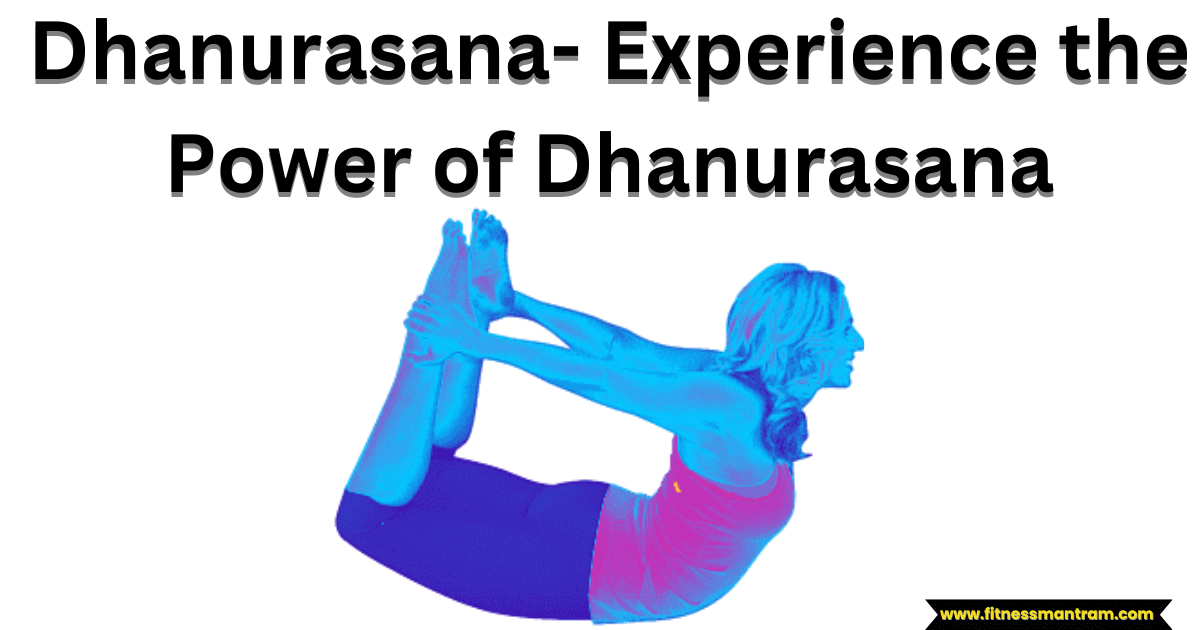Discover the transformative benefits of Dhanurasana, the Bow Pose. Enhance flexibility, relieve back pain, and find inner peace with this powerful yoga asana. Learn how to practice Dhanurasana correctly, explore modifications, and understand its impact on the chakras. Find answers to FAQs and unlock the potential of this rejuvenating pose. So be ready to walk on the path of self-discovery with Dhanurasana.
Dhanurasana: Unleashing the Power of the Bow Pose
Dhanurasana, also known as the Bow Pose, is a popular asana in the practice of yoga. It is derived from the Sanskrit words “dhanu” which means “bow” and “asana” which means “pose.” The name is given because while performing yoga practice, in this pose our body resembles and make the shape of a bow. Dhanurasana offers numerous physical, mental, and spiritual benefits, making it a valuable addition to any yoga routine.
Introduction to Dhanurasana
Dhanurasana is a dynamic backbend that engages the entire body. It stretches the front of the body while simultaneously strengthening the back muscles. The pose requires a deep opening of the chest, which promotes improved breathing and circulation. Dhanurasana is often included in sequences aimed at energizing the body and increasing flexibility.
History and Origin of Dhanurasana
The practice of this yoga pose dates back thousands of years and finds its roots in ancient yoga traditions. This asana is mentioned in the classic yoga texts such as the Hatha Yoga Pradipika and the Gheranda Samhita. This yoga practice was developed so as to maintain flexibility and physical health, as well as getting our body prepared to undergo longer form of meditation techniques.
Benefits of Dhanurasana
Physical Benefits
This yoga pose offers a wide range of physical benefits. First, it helps improve body posture and help in to reduce back pain by strengthening a set of muscles that straighten and rotate the back, known as erector spinae muscles. It increases the body flexibility by stretching the entire front portion of the body which includes chest, abdomen and hip flexors. Additionally, this yoga asana stimulates the digestive organs, enhancing digestion and relieving constipation.
Mental and Emotional Benefits
In addition to the physical advantages, this asana also provides mental and emotional benefits. This pose stimulates the solar plexus, which is associated with the release of emotions and the ability to assert oneself. Regular practice of this asana can help relieve stress, anxiety, and mild depression by promoting a sense of calmness and inner balance.
How to do Dhanurasana ?
Follow the steps as shown below to perform Dhanurasana
- Lie flat on your stomach keep your arms by your sides and your palms facing up.
- Bend your knees and reach your arms back to grasp your ankles or feet.
- Inhale deeply, and as you exhale, lift your chest and legs
- Inhale deeply, and as you exhale, lift your chest and legs off the ground, simultaneously pulling your ankles or feet towards your buttocks.
- Keep your gaze forward and maintain a gentle smile on your face.
- Hold the pose for 20 to 30 seconds while focusing on your breath.
- Slowly release the pose by gently lowering your chest and legs back to the ground as you exhale.
- Perform and practice the pose 2 to 3 times, once you’re are familiar and feel comfortable with this pose you can gradually increase the duration.
Modifications and Variations
If reaching your ankles or feet is challenging, you can use a yoga strap to loop around your ankles and hold onto the ends. This will provide additional support and allow you to focus on the alignment of your body.
For beginners or those with limited flexibility, you can start by practicing a modified version of Dhanurasana. In order to practice and perform this asana, you must first lay down on your stomach and then lift one leg at a time while keeping your other leg on the ground. Hold your breaths for few seconds and then switch to another sides.
Precautions To Be Taken While Performing this Asana
While Dhanurasana offers numerous benefits, it is essential to practice with caution and be aware of any contraindications. Avoid this pose if you have:
- High or low blood pressure
- Herniated discs or severe back pain
- Recent abdominal or back surgeries
- Carpal tunnel syndrome
- Migraines or headaches
It is always advisable to consult and speak with a health care expert or to a certified yoga teacher before starting any new exercise or yoga practice specially if you are undergoing any physical or mental health issues.
Tips for Beginners
For a new beginner to Dhanurasana, given below are some helpful and useful tips to enhance your practice:
- Before starting to perform this asana, you need to warm up your body with few simple and gentle stretching exercise and Sun Salutations
- Focus on maintaining proper alignment by keeping your knees hip-width apart and your feet parallel.
- Engage your core muscles to support your lower back and avoid any discomfort.
- Don’t make it hard, take it slowly and listen your body. Do not force yourself into a deep backbend if it feels uncomfortable or painful.
Incorporating Dhanurasana into a Yoga Routine
Dhanurasana can be incorporated into a well-rounded yoga routine to enhance its benefits. You can include it in a sequence focused on backbends or as part of a more dynamic flow. Pairing Dhanurasana with complementary poses such as Cobra Pose (Bhujangasana) or Camel Pose (Ustrasana) can create a balanced practice that targets the entire spine.
The Significance of Breath in Dhanurasana
Breath awareness is crucial during the practice of Dhanurasana. Inhale deeply by lifting your legs and chest, expand your chest which allows your breath to flow freely. Maintain a steady and controlled breath throughout the pose, exhaling as you release and come back to the starting position. The breath serves as a guide, helping you deepen your stretch and stay present in the moment.
Dhanurasana and its Impact on the Chakras
Dhanurasana stimulates several chakras or energy centers in the body. It primarily activates the Anahata (heart) chakra, which governs love, compassion, and emotional balance. By opening the chest and expanding the heart center, Dhanurasana can help release emotional blockages and foster a greater sense of love and connection.
Dhanurasana For Stress Relief and Relaxation
One of the key benefits of Dhanurasana is its ability to alleviate stress and promote relaxation. By engaging the back muscles and opening the chest, this pose helps release tension and encourages deep breathing. It also helps in elongation of spine and in parasympathetic nervous system which in turn brings tranquillity and calmness. Practicing Dhanurasana regularly can be a powerful tool in managing stress and finding inner peace.
Dhanurasana for Back Pain Relief
Dhanurasana is known for its effectiveness in relieving back pain. By strengthening the back muscles and stretching the muscles in the front, this yoga pose helps in to correct body posture issues and ease back pain. The gentle compression applied to the abdominal region during the pose also stimulates the digestive organs and improves their functioning. Most important, in the past if you were suffering from severe back pain or injuries, then it is very essential to perform and practice this asana under the supervision of a certified yoga instructor.
Exploring the Spiritual Aspects of Dhanurasana
Beyond the physical and mental benefits, Dhanurasana holds spiritual significance. In yoga philosophy, the bow is seen as a symbol of the divine archer and represents the merging of individual consciousness with universal consciousness. As you assume the shape of a bow, you open yourself to receiving higher energies and wisdom. The practice of Dhanurasana can deepen your connection to the spiritual aspects of yoga and cultivate a sense of unity and oneness.
Akarna Dhanurasana
Akarna Dhanurasana, also known as Archer Pose, is a seated yoga asana that involves a deep stretch for the legs and hips. Here’s how to practice Akarna Dhanurasana:
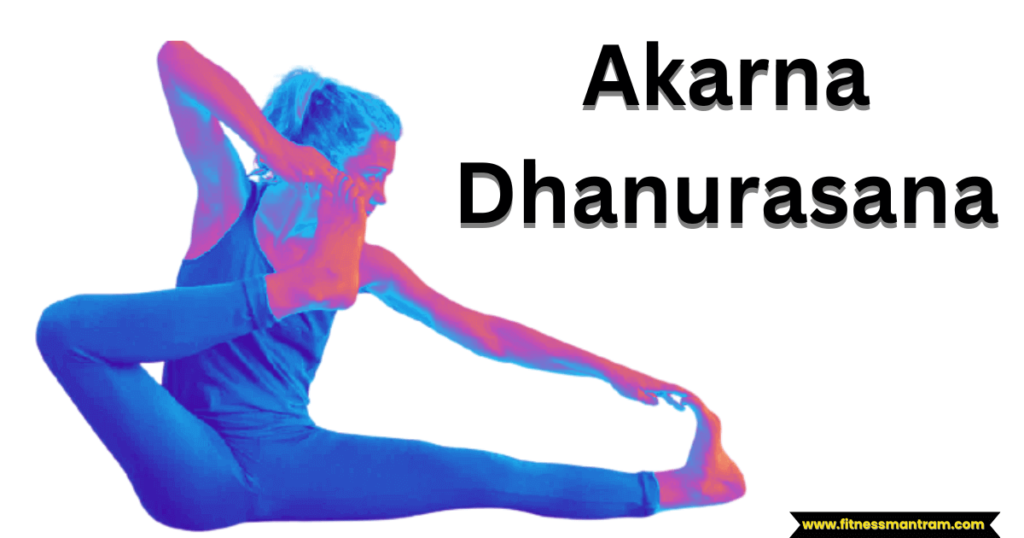
- Start by sitting on the floor with your legs extended straight in front of you.
- Bend your right knee and bring the sole of your right foot to the inner side of your left thigh, keeping your left leg extended.
- Inhale deeply and raise your left arm overhead, stretching it towards the right side.
- Exhale and bend your torso towards the left side, reaching your left hand towards your left foot.
- As you continue to breathe deeply, bend your left elbow and hold the outside of your left foot or ankle with your left hand.
- Extend your right arm straight out to the right side, parallel to the floor. Keep Your right hand in accordance with your right shoulder, fingers pointing forward.
- Keep your spine straight and gaze towards the right fingertips.
- Hold the pose for 30 seconds to 1 minute, breathing deeply and maintaining your balance.
- To release the pose, slowly straighten your torso and lower your left hand and leg back to the starting position.
- Repeat the same steps on the other side, bending your left knee and stretching towards the left side.
Akarna Dhanurasana provides a deep stretch for the legs, hips, and side body, while also improving balance and concentration. It is important to listen to your body and practice with awareness, not forcing any movements that feel uncomfortable or painful. Always seek advice and consult with a yoga expert instructor, if there is a need to do any modifications based on your individual requirements and abilities while performing this asana.
Dhanurasana Yoga
Dhanurasana, also known as Bow Pose, is a yoga asana that resembles the shape of a bow when practiced. It is a backbend that stretches the entire front of the body and strengthens the back muscles. Here’s how to practice Dhanurasana
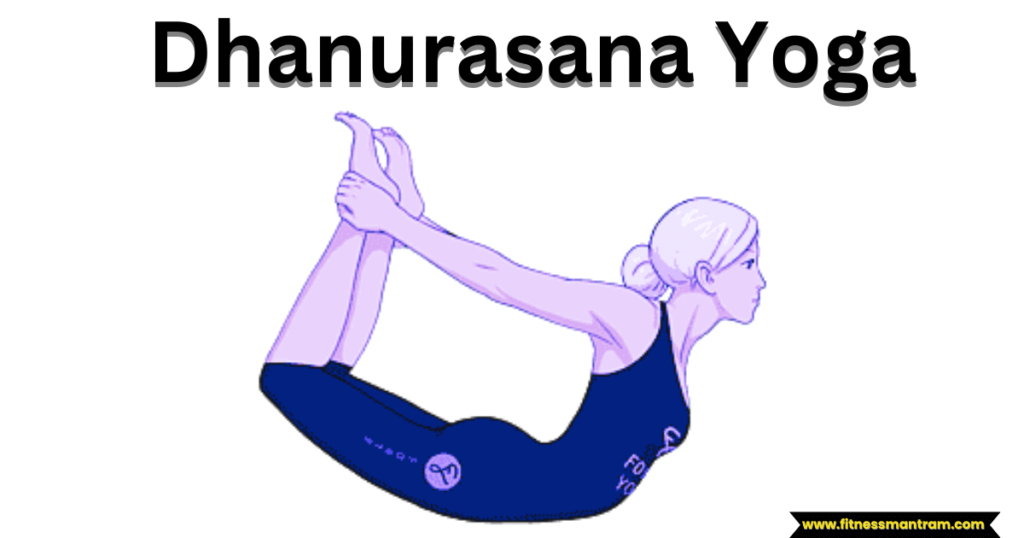
- Lie flat on your stomach with your feet hip-width apart and your arms by your sides.
- Bend your knees and bring your heels close to your buttocks, keeping them hip-width apart.
- Reach your hands back and grab your ankles or feet, ensuring a firm grip.
- Inhale deeply and lift your chest off the ground while simultaneously kicking your feet into your hands.
- Lift your thighs off the ground and aim to create a gentle curve in your spine, resembling the shape of a bow.
- Keep your gaze forward and maintain a steady breath throughout the pose.
- Hold the pose for 20-30 seconds, or as long as you are comfortable. Once you are familiar with this pose then you can slowly increase the duration.
- To release the pose, exhale and gently lower your chest, thighs, and feet back to the ground.
- Extend your legs and rest in Child’s Pose (Balasana) for a few breaths to counterbalance the backbend.
There are several other benefits of Dhanurasana like it stretches the front portion of the body, opens the chest and shoulders, strengthens the muscles in the back, stimulates the organs in the abdominal cavity, and also helps in to improves body posture. While doing this yoga pose it is essential to follow the instruction as given by your yoga instructor, and in case if you feel discomfort while performing or in the past if you had any health issues it is always advisable to speak to a certified yoga teacher before trying to perform Dhanurasana or any other yoga pose.
Urdhva Dhanurasana
Urdhva Dhanurasana, also known as Upward Bow Pose or Wheel Pose, is an advanced yoga asana that involves a deep backbend. It is an energizing pose that strengthens the arms, legs, and core while opening the chest and shoulders. Here’s how to practice Urdhva Dhanurasana
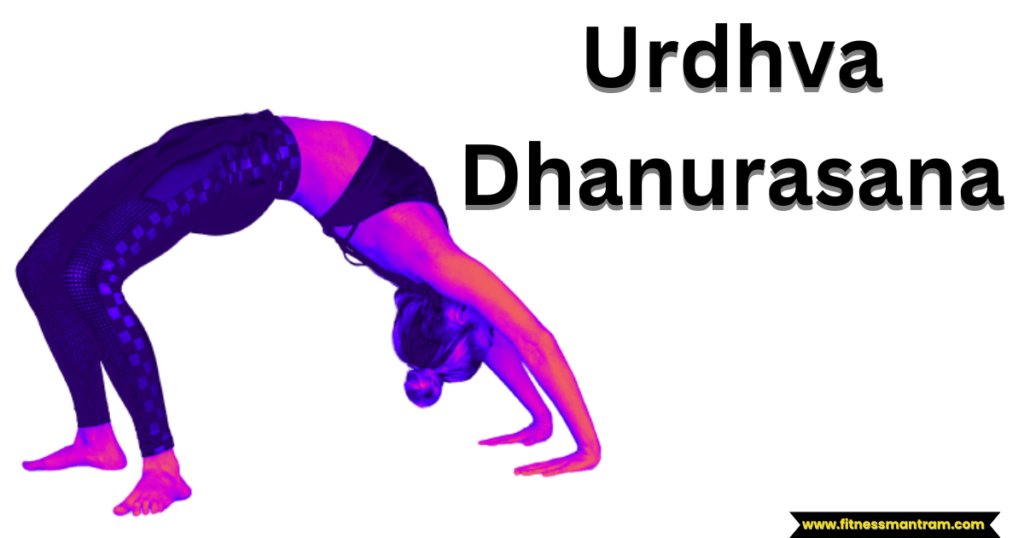
- Begin by lying flat on your back on a yoga mat or a comfortable surface.
- Bend your knees and place your feet flat on the floor, hip-width apart, with your heels as close to your sitting bones as possible.
- Bend your elbows and place your palms on the ground, fingers pointing towards your shoulders, with your fingertips pointing towards your feet.
- Press firmly into your palms and lift your shoulders and head off the ground, placing the crown of your head on the mat.
- Inhale deeply, engage your core, and press into your hands and feet as you lift your hips off the ground.
- Straighten your arms and legs as much as possible, actively pushing the floor away with your hands and lifting your chest towards the ceiling.
- Keep your thighs parallel to each other and your feet grounded, distributing the weight evenly.
- Relax your neck and allow your head to hang freely, or if comfortable, gently tuck your chin towards your chest.
- Hold the pose for several breaths, focusing on maintaining a steady breath and finding a balance between effort and ease.
- To release the pose, exhale and slowly lower your body back down to the mat, one vertebra at a time.
Urdhva Dhanurasana offers numerous benefits, including strengthening the arms, shoulders, legs, and back, increasing flexibility in the spine and shoulders, improving posture, and boosting energy levels. It is a challenging pose that requires proper warm-up and guidance. It is always said to practice and perform this yoga pose under the supervision of a qualified yoga instructor to ensure proper alignment and to prevent strain or physical injury, basically if you are beginner or if you have any previous injuries and you are undergoing medical treatment
Purna Dhanurasana
Purna Dhanurasana, also known as Full Bow Pose, is an advanced variation of Dhanurasana (Bow Pose) that involves a deep backbend while balancing on the abdomen. It is an intense pose that requires flexibility, strength, and control. Here’s how to practice Purna Dhanurasana
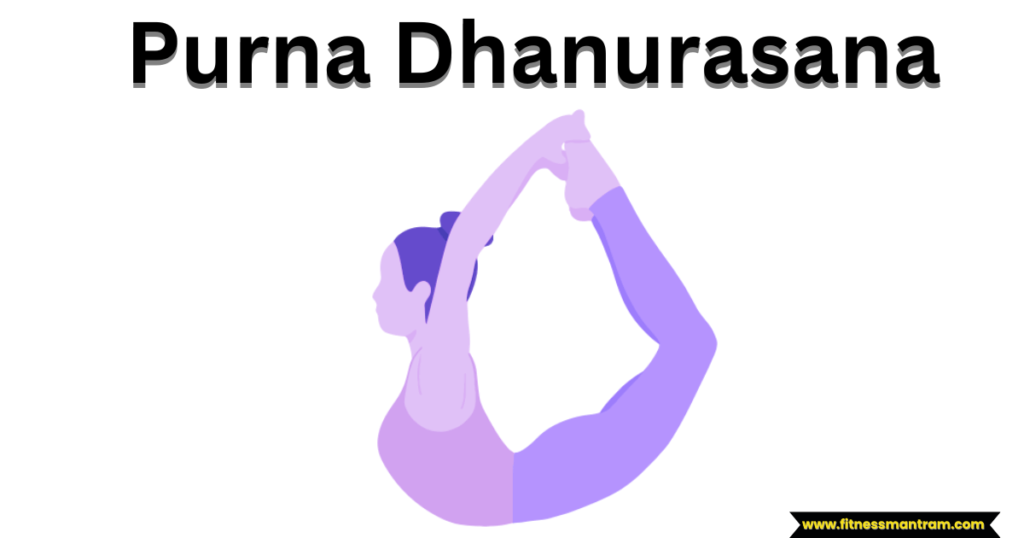
- Begin by lying flat on your stomach on a yoga mat or a comfortable surface.
- Bend your knees and bring your heels close to your buttocks, keeping them hip-width apart.
- Reach your hands back and grab your ankles or feet, ensuring a firm grip.
- Inhale deeply and lift your chest off the ground, just like in Dhanurasana.
- As you exhale, kick your feet into your hands and simultaneously lift your thighs and knees off the ground.
- Continue to lift your chest and bring your gaze forward, maintaining a steady breath.
- Now, to move into the full expression of the pose, slowly start lifting your lower legs off the ground, aiming to bring them parallel to the floor.
- Balance on your abdomen and try to hold the pose for a few breaths, finding stability and extending the backbend.
- Maintain a strong grip on your feet or ankles, keeping the pose active and engaged.
- To release the pose, exhale and gently lower your chest, thighs, and feet back to the ground.
- Extend your legs and rest in Child’s Pose (Balasana) or Corpse Pose (Savasana) for a few breaths to relax the back and restore your energy.
Purna Dhanurasana offers various benefits, including deep stretching of the entire front body, strengthening of the back muscles, improved posture, increased flexibility, and stimulation of the abdominal organs. Due to its advanced nature, it is essential to approach this pose with caution. If you are performing for the first time and you are new to this pose or if you have any pre-existing back or spine related issues, it is always said to practice under the direction of a skilled yoga instructor. Listen to your body, respect your limitations, and avoid pushing yourself beyond what feels safe and comfortable.
Frequently Asked Questions
Is Dhanurasana suitable for everyone?
Dhanurasana is generally safe for most individuals. before you try to practice this yoga pose, as always said you need to consult to a qualified yoga instructor and take personal advice whether to continue or stop the practice till you overcome your pre-existing health issues like high blood pressure, severe back pain, or herniated discs,
Can I practice Dhanurasana during pregnancy?
It’s best to consult with a prenatal yoga specialist who can guide you through safe and suitable modifications. Basically, Dhanurasana should not be performed and practiced by any pregnant women, especially if you’re in the second and third trimesters.
How long should I hold Dhanurasana?
Start by holding Dhanurasana for 20 to 30 seconds and gradually increase the duration as your body becomes more comfortable with the pose. Don’t push yourself hard beyond your health limits, always stop the practice if you are not comfortable with it
Can Dhanurasana help with weight loss?
Dhanurasana, along with a consistent yoga practice and a healthy lifestyle, can contribute to weight management. This pose engages multiple muscle groups, improves metabolism, and enhances digestion. To get better result it is necessary to follow the complete weight loss program such as regular exercise and a well-balanced diet
Can Dhanurasana cure digestive disorders?
Dhanurasana stimulates the abdominal organs, improves digestion, and helps alleviate constipation. Even though it is helpful in digestive health, it is essential to talk to a health care expert to overcome specific digestive problem and to follow a complete diet plan
Conclusion
In conclusion, Dhanurasana, or the Bow Pose, is a transformative yoga asana that offers a multitude of physical, mental, and spiritual benefits. By integrating this yoga posture into your daily practice, after few weeks you will experience the change in your flexibility, more improved body posture, increase in your self-confidence and also in stress relief. Remember to approach Dhanurasana with mindfulness, honouring your body’s limitations and seeking guidance from a qualified yoga instructor when needed. Embrace the power of the Bow Pose and unlock its potential to enhance your overall well-being.
Start your fitness journey With Dhanurasana towards inner confidence self – discovery and transformation So, unroll your yoga mat, breathe deeply, and surrender to the beauty of this powerful asana.
You May Also Like
- Gomukhasana: Discover the Healing Power of Gomukhasana
- Swastikasana: Discover the Hidden Benefits of Swastikasana
- 28-Day Wall Pilates Challenge – Elevate Your Fitness Journey
- Hyperbolic Stretching: The 30-Day Secret To Full Splits
- Hindu Squats: Hindu Squats vs Normal Squats
Disclaimer : The details & information given here in this article is based on information as available on other published site on internet. Do take medical advice before adopting it. Fitness Mantram Does Not Confirm It. This site contains affiliate links. If you choose to make a purchase after clicking a link the author/owner/creator may receive a commission at no ADDITIONAL cost to you. Thank you for your support!
